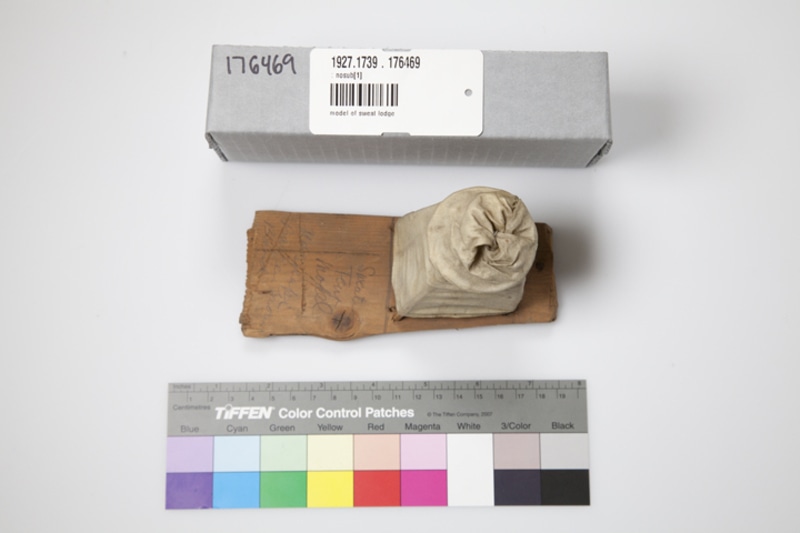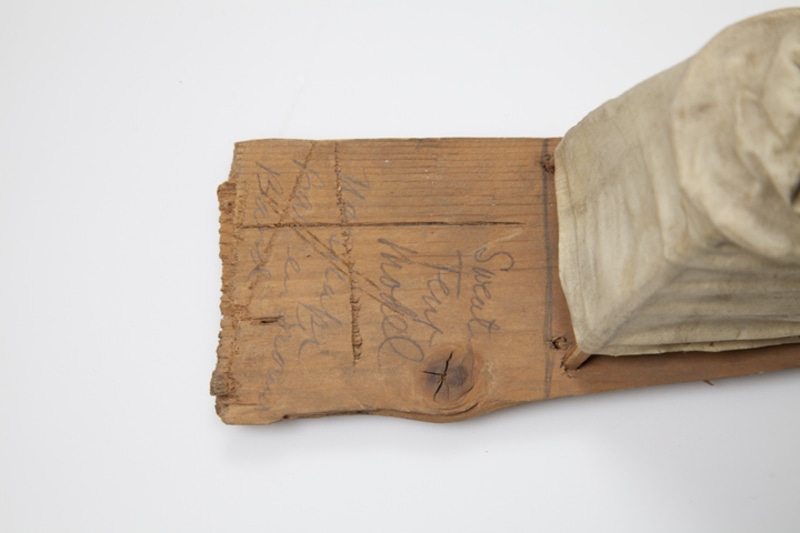model of sweat lodge Item Number: 1927.1739 . 176469 from the The Field Museum




Citations From Vanstone (1982) Article
« The Montagnais-Naskapi believed that taking a sweat bath, like drumming, strengthened the will and "reinforced the soul spirit" of the individual (Speck, 1935, p. 212). The collection contains a model bathhouse from the Barren Ground band which is described in Speck's notes as being the "scene of a shaman's efforts." It consists of four narrow sticks of wood set in a wooden base and slanting toward one another at the top. Another strip is bent to circle the four at the top and lashed to them. This framework is covered with a strip of tanned caribou skin, the ends of which are sewn together with sinew (fig. 26a). The bathhouses of the Lake St. John Montagnais, the Mistassini, and the Naskapi of northern Labrador are all described as being dome-shaped and formed of poles thrust in the ground to form a circular enclosure (Speck, 1935, p. 212; Rogers, 1967, p. 14; Turner, 1894, p. 299). Rather than a bathhouse as Speck indicates, this specimen may be a model of a "shaking tent," a specially constructed lodge in which a shaman conversed with spirits (E. S. Rogers, personal communication). »
Vanstone, James W. "The Speck Collection of Montagnais Material Culture from the Lower St. Lawrence Drainage, Quebec." Fieldiana. Anthropology. New Series, No. 5 (October 29, 1982), p.21.
Translation Of Citations From Vanstone (1982) Article
« Les Montagnais-Naskapis croyaient que prendre un bain de sueur, tout comme jouer du tambour, fortifiait la volonté et « renforçait l’esprit de l’âme» de l’individu(Speck, 1935, p. 212). La collection contient un modèle de tente de sudation provenant de la bande de Barren Ground et qui est décrit dans les notes de Speck comme étant la « scène des efforts du shaman ». Il est fait avec des bâtonnets de bois étroits placés dans une base de bois et penchés les uns vers les autres vers le haut. Un autre bâtonnet est plié pour entourer les quatre autres en haut et leur est attaché. Cette structure est couverte par une bande de peau de caribou tannée, dont l’extrémité est cousue par un tendon (fig. 26a). Les sonas des Montagnais du Lac-Saint-Jean, des Mistassinens et des Naskapis du nord du Labrador sont tous décrits comme ayant une forme en dôme et sont construits avec des perches qui s’enfoncent dans le sol pour former une enceinte circulaire (Speck, 1935, p. 212; Rogers, 1967, p. 14; Turner, 1894, p. 299). Plutôt qu’un sona, comme Speck l’indique, ce modèle peut être une reproduction d’une « tente tremblante, » une loge spécialement construite pour que le shaman dialogue avec les esprits (E. S. Rogers, communication personnelle). »
Vanstone, James W. "The Speck Collection of Montagnais Material Culture from the Lower St. Lawrence Drainage, Quebec." Fieldiana. Anthropology. New Series, No. 5 (October 29, 1982), p.21.
Item History
- Made in Pekuakami, Lac Saint-Jean, Lake St. John, Labrador, Canada
What
- Name
- model of sweat lodge
- Identification Number
- 1927.1739 . 176469
- Type of Item
- model of sweat lodge
- Material
- skin covered
Who
- Culture
- Ilnu, Montagnais and Innu
Where
- Holding Institution
- The Field Museum
- Made in
- Pekuakami, Lac Saint-Jean, Lake St. John, Labrador, Canada
Other
- Nom De L'objet
- Réplique de tente de sudation
- Matériaux
- recouvert de peau
- Ethnic Group
- Montagnais
- Collection
- Lake St. John Objects
- Provenience
- North America, Canada, Quebec, Labrador